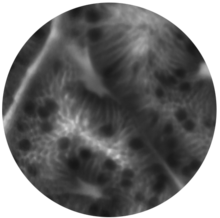- Mauna Kea Technologies
-
Mauna Kea Technologies

Type Public (MKEA:FP) Industry Medical Technology Founded 2000 Headquarters Paris, France Key people Sacha Loiseau, Founder and CEO Products Cellvizio Employees 70 Website www.maunakeatech.com Mauna Kea Technologies is a global medical device company focused on leading innovation in endomicroscopy, the field of microscopic imaging during endoscopy procedures. The company researches, develops and markets tools to visualize, detect and rule out abnormalities including malignant and pre-malignant tumors or lesions in the gastrointestinal and pulmonary tracts.
The company’s flagship product, Cellvizio, a probe-based Confocal Laser Endomicroscopy (pCLE) system, provides physicians and researchers with real-time access to histological information during standard endoscopy procedures through high-resolution cellular imaging of internal tissues.
Cellvizio went public in July 2011 and trades on the NYSE Euronext exchange.
Contents
Timeline
History 2000 Founding of Mauna Kea Technologies 2005 Cellvizio pCLE system receives U.S. Food and Drug Administration (FDA) clearance and CE mark in the European Union 2008 Cellvizio named runner-up in the medical device category of The Wall Street Journal’s 2008 Technology Innovation Awards [1] 2010 Cellvizio systems installed in over 180 hospitals and research centers worldwide 2011 Launch of Cellvizio 100 Series; Initial Public Offering Technology
Cellvizio
The Cellvizio system can be used during any endoscopy procedure, offering a cellular-level view of internal tissue. Large, international, multi-center clinical trials have demonstrated Cellvizio's ability to help physicians to more accurately detect disease in real time, confirm the absence of disease and make immediate treatment decisions.
The Cellvizio system includes miniaturized optics, optical fiber bundles, high-speed scanning and advanced image processing components. The embedded real-time image processing software, combined with a high-speed Laser Scanning Unit (LSU), allows the Cellvizo system to produce sharp images at 12 frames per second.
Mauna Kea Technologies developed a series of Cellvizio confocal miniprobes designed specifically for various endoscopy procedures. The resolution of Cellvizio images depends on the type of miniprobe used.
The Cellvizio system has received 510(k) clearance from the U.S. Food and Drug Administration (FDA) and the European CE-Mark for use in the GI and pulmonary tracts.
Over 300 physicians and researchers at more than 200 international hospitals and research centers use the Cellvizio system. Over 10,000 patients have undergone endoscopy procedures where Cellvizio was used.
Clinical Applications
Through multiple clinical trials, the use of pCLE has been shown to be beneficial to the detection and/or characterization of pre-cancerous lesions.
Barrett’s Esophagus
Cellvizio provides a direct method to visualize the microstructure of the esophagus and differentiate normal versus abnormal Barrett’s Esophagus (BE) tissue in real-time which may improve targeted sampling, provide earlier disease detection and help patient management.[2] Physicians have also used Cellvizio imaging in conjunction with other clinically relevant parameters during BE treatment procedures to guide resection or ablation, to evaluate margins for residual malignancy and to visually monitor the patient’s condition during follow-up endoscopy procedures.[3] In many cases, unnecessary procedures may be avoided which may impact on overall costs, such as endoscopy suite time and pathology testing.
Colorectal Neoplasia
During standard colonoscopy procedures, physicians remove all polyps and send them to a pathologist for analysis. pCLE with Cellvizio can magnify a polyp by a factor of 1,000 to help a physician detect cellular-level features that differentiate cancerous from benign colorectal polyps during the colonoscopy procedure in real time. With the additional information provided by Cellvizio, the physician can use his/her medical judgment to either leave the polyp or remove it and send it for pathological analysis or just discard it.[4]
Physicians also use Cellvizio during follow-up colonoscopies to re-examine polyp resection sites to determine if re-treatment is necessary.[5]
Mauna Kea Technologies hopes to expand Cellvizio’s use in:
- Urology
- Surgery
- Solid tumors
Pre-Clinical Research
Mauna Kea Technologies also developed the Cellvizio LAB system for use in pre-clinical medical research laboratories.
The system’s ultra-thin, highly flexible fibered microprobes come in a variety of sizes and tip shapes that are designed to facilitate imaging of different areas of a living animal. The Cellvizo LAB laser scanning unit (LSU) comes in three models, functioning at either 488, 568 or 660 nm, which allows it to function with a wide array of standard dyes or transgenic animals. The system’s ImageCell software performs the on-the-fly image processing that provides users with high-quality, high-definition video sequences in real-time.
Research applications include deep brain imaging, angiogenesis, peripheral nervous system visualization, GI Cancer research, stem cells and pancreatic cancer imaging.
Cellvizio LAB is sold and marketed to U.S. research labs through a distribution agreement with Sonosite’s Visualsonics unit.
Headquarters and Global Presence
European Mauna Kea Technologies 9 rue d'Enghien, 75010 Paris, France (RCS 431268028)
North American Mauna Kea Technologies, Inc., 660 Newtown-Yardley Road, Suite 107, Newtown, PA 18940 USA
References
- ^ Wall Street Journal: The 2008 Technology Innovation Awards
- ^ Sharma P. et al, Real-time Increased Detection of Neoplastic Tissue in Barrett’s Esophagus with probe-based Confocal Laser Endomicroscopy: Final Results of a Multi-center Prospective International Randomized Controlled Trial. GIE, 2011, accepted for publication.
- ^ Wallace M. et al, Multicenter, Randomized Controlled Trial of Confocal Laser Endomicroscopy Assessment of Residual Neoplasia after Musocal Ablation or Resection of Gastrointestinal Neoplasia in Barrett’s Esophagus (CLEAN MARGIN, BE), Preliminary Report, ICCU 2011, oral presentation.
- ^ . PMID 19909747.
- ^ http://clinicaltrials.gov/ct2/show/NCT01032044?term=clean+margin+and+pcle&rank=1
Categories:- Medical technology
- Companies based in Paris
Wikimedia Foundation. 2010.

